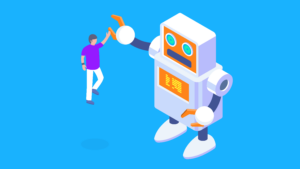Author: Steffen Meyer, Mobile Marketing Content Specialist
Content Farms are back and they are worse than ever – thanks to Artificial Intelligence.
There are now hundreds of websites which host AI generated content with obviously no human oversight. Sometimes, the headlines begin with the words “Sorry, as an AI language model I can’t…” and some articles are just filled with chinese or arabic letters despite having a headline in English or German.
Even the most inept human editor-in-chief couldn’t let these blunders slip by, illustrating just how unreliable the actual articles can be. It’s important to remember that generative AI tools still struggle with hallucinations.
Though by producing content en masse – sometimes up to a thousand articles per day -, these robot sites attract clicks and views which are attractive to online advertising. Most of all Google’s Display Ads.
Running Google Ads is risky without expert guidance
According to a recent study conducted by NewsGuard, a tool that monitors and evaluates website credibility, an astonishing 90% of these robot sites featured Google-run ads, with renowned brands prominently displayed among them.
This comes as no surprise, given that Google remains the top choice for website ads. Since it is implemented on many pages, marketers can effortlessly reach vast audiences by setting up a single campaign and letting Google handle the distribution.
The case of these robot farms serves as a stark reminder of the potential dangers that marketers face when running ads on Google without professional assistance. Brand advertisements may inadvertently end up alongside fake news, resulting in wasted ad spend and brand reputation damage.
Following NewsGuard’s communication with Google, the company took action by removing the ads from most of the sites due to “pervasive policy violations.” However, there is no guarantee that similar incidents won’t recur in the future.
The onset of the AI Content Tsunami
This marks the initial signs of the impending AI Content Tsunami, as elaborated in our blog post. The prevalence of generative AI has unleashed an overwhelming flood of content on the internet, including these next-generation content farms.
In stark contrast to the early content farms of the 2010s, fraudsters are no longer limited by human typing or copy-pasting speed; instead, their constraints are only determined by the ever-increasing processing speed of AI, which is poised to surge in the coming times
This again drives up demand for companies that focus on identifying AI fraudsters, so that brands know where to advertise safely. Many of these brand safety firms are investing into AI technology to root out AI fraudsters.
It’s robots hunting robots. And it’s just beginning.
💡 Knowledge sharing is at the core of what we do. Get our Marketing Master Map, sign up for our newsletter and become part of our community on LinkedIn to learn how to make apps succeed in the competitive mobile landscape.
Helpful Links:






